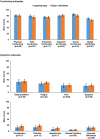Association of laparoscopic colectomy versus open colectomy on the long-term health-related quality of life of colon cancer survivors
- PMID: 31993822
- PMCID: PMC8144161
- DOI: 10.1007/s00464-019-07360-2
Association of laparoscopic colectomy versus open colectomy on the long-term health-related quality of life of colon cancer survivors
Erratum in
-
Correction to: Association of laparoscopic colectomy versus open colectomy on the long‑term health‑related quality of life of colon cancer survivors.Surg Endosc. 2021 Aug;35(8):4900. doi: 10.1007/s00464-021-08557-0. Surg Endosc. 2021. PMID: 34032920 Free PMC article. No abstract available.
Abstract
Background: Laparoscopic colectomy (LC) is a less invasive alternative to open colectomy (OC) in the treatment of stage I-III colon cancer. Research on the long-term (5-year post-diagnosis) health-related quality of life (HRQOL) of LC patients is scarce. Our study aimed to compare the long-term HRQOL and psychological well-being of stage I-III colon cancer survivors treated either with LC or OC.
Methods: This study used a German population-based cohort of patients treated with either LC (n = 86) or OC (n = 980). LC patients were matched to OC patients using a propensity score. At 5-year follow-up, patients completed assessments on HRQOL (EORTC QLQ-C30 and EORTC QLQ-CR29) and psychological well-being (distress and disease/treatment burden). Least square mean scores of HRQOL were derived using linear regression. Proportions of patients with moderate/high distress and disease/treatment burden were compared with Chi-square tests.
Results: In total, 81 LC patients were matched to 156 OC patients. Generally, LC patients had HRQOL comparable to OC patients, albeit LC patients reported significantly better body image (87.1 versus 81.0, p = 0.03). Distress levels were generally low and comparable between the two groups, even though LC patients were more likely to experience disease recurrence (16% versus 7%, p = 0.02) than OC patients. OC patients were more likely to feel moderate/high levels of burden associated with the treatment (72% versus 56%, p = 0.01) and the time after treatment completion (43% versus 28%, p = 0.02).
Conclusion: LC patients reported comparable long-term HRQOL outcomes but higher levels of psychological well-being than OC patients 5 years after diagnosis, even though LC was associated with higher risk of disease recurrence.
Keywords: Colon cancer; Health-related quality of life; Laparoscopy; Long-term survivor; Population based; Propensity score.
Conflict of interest statement
Profs Brenner, Chang-Claude, Drs Arndt, Jansen, Hoffmeister, and Thong have no conflicts of interest or financial ties to disclose.
Figures




Similar articles
-
Laparoscopic vs. open surgery for T4 colon cancer: A propensity score analysis.Int J Colorectal Dis. 2016 Nov;31(11):1785-1797. doi: 10.1007/s00384-016-2646-y. Epub 2016 Sep 14. Int J Colorectal Dis. 2016. PMID: 27627964
-
Prospective evaluation of health-related quality of life after laparoscopic colectomy for cancer.Tech Coloproctol. 2013 Feb;17(1):27-38. doi: 10.1007/s10151-012-0869-7. Epub 2012 Oct 13. Tech Coloproctol. 2013. PMID: 23065134
-
Oncological outcomes following laparoscopic surgery for pathological T4 colon cancer: a propensity score-matched analysis.Surg Today. 2021 Mar;51(3):404-414. doi: 10.1007/s00595-020-02106-3. Epub 2020 Aug 7. Surg Today. 2021. PMID: 32767131
-
Quality of life after laparoscopic colectomy for cancer.JSLS. 2014 Apr-Jun;18(2):225-35. doi: 10.4293/108680813X13753907291152. JSLS. 2014. PMID: 24960485 Free PMC article. Review.
-
Laparoscopic versus open surgery for colon cancer: a meta-analysis of 5-year follow-up outcomes.Surg Oncol. 2013 Sep;22(3):e39-43. doi: 10.1016/j.suronc.2013.03.002. Epub 2013 May 3. Surg Oncol. 2013. PMID: 23643698 Review.
Cited by
-
The Quality of Life of Patients with Surgically Treated Colorectal Cancer: A Narrative Review.J Clin Med. 2022 Oct 21;11(20):6211. doi: 10.3390/jcm11206211. J Clin Med. 2022. PMID: 36294531 Free PMC article. Review.
-
Persisting Deficits in Health-Related Quality of Life of Colorectal Cancer Survivors 14-24 Years Post-Diagnosis: A Population-Based Study.Curr Oncol. 2023 Mar 14;30(3):3373-3390. doi: 10.3390/curroncol30030257. Curr Oncol. 2023. PMID: 36975470 Free PMC article.
References
Publication types
MeSH terms
LinkOut - more resources
Full Text Sources
Medical

